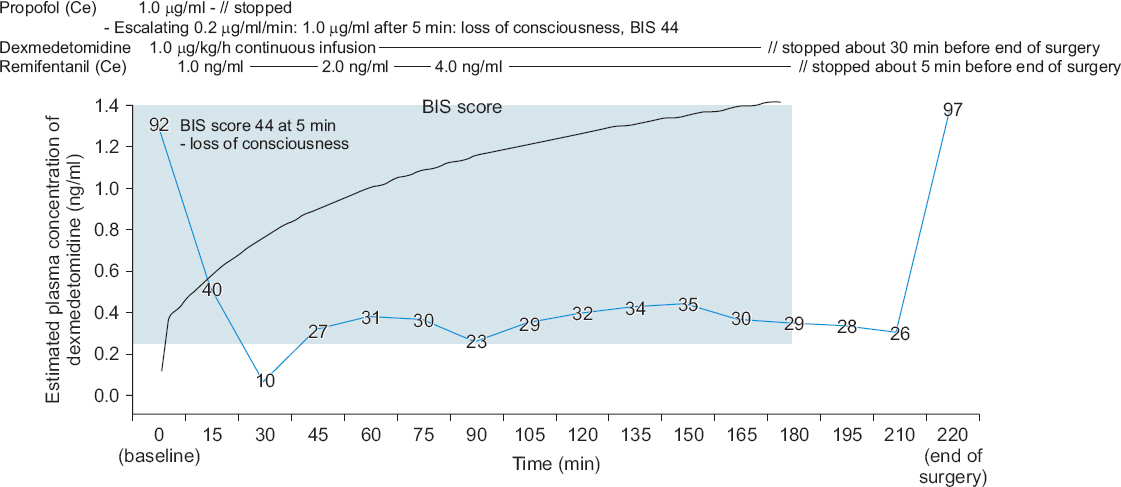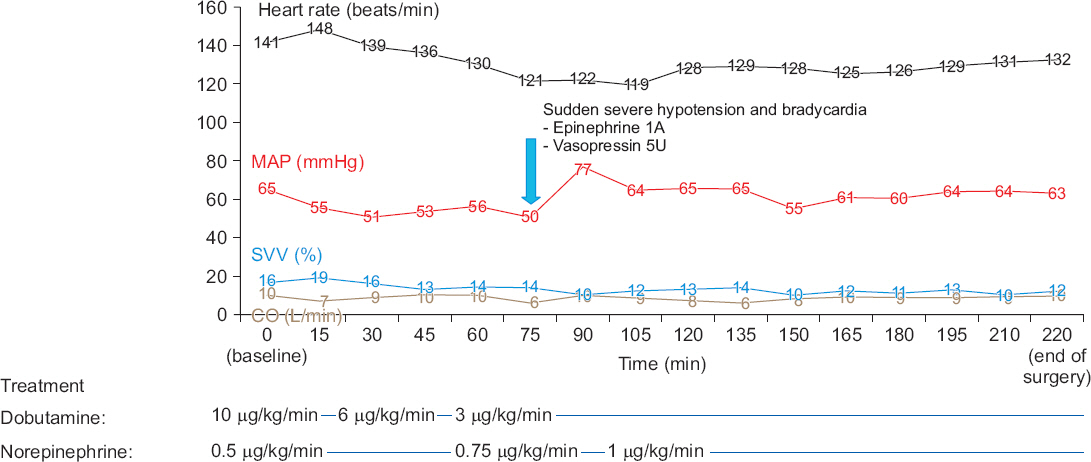Anesth Pain Med.
2019 Oct;14(4):416-422. 10.17085/apm.2019.14.4.416.
Dexmedetomidine as a non-triggering anesthetic agent in a patient with MELAS syndrome and systemic sepsis: A case report
- Affiliations
-
- 1Department of Anesthesiology and Pain Medicine, Chosun University Hospital, Gwangju, Korea. mdmole@chosun.ac.kr
- KMID: 2465339
- DOI: http://doi.org/10.17085/apm.2019.14.4.416
Abstract
- BACKGROUND
The selection of anesthetic agents is important in mitochondrial myopathy, encephalopathy, lactic acidosis, and stroke-like episodes (MELAS) syndrome patient because serious and unexpected complications can occur after anesthetic exposure. CASE: A 30-year-old man with MELAS syndrome and sepsis underwent colectomy. Propofol was administered by step-wise until target effect-site concentration (Ce) 1.0 µg/ml and stopped for the loss of consciousness and to avoid hemodynamic instability. After the loss of consciousness, total intravenous anesthesia (TIVA) using dexmedetomidine (1.0 µg/ml/h) and remifentanil (1-4 ng/ml of Ce) was performed for the maintenance of anesthesia to avoid malignant hyperthermia and mitochondrial dysfunction. During the surgery, the bispectral index score stayed between 26 and 44, and increased to 97 after the end of anesthesia.
CONCLUSIONS
TIVA with dexmedetomidine and remifentanil as non-triggering anesthetic agents in patients with MELAS syndrome and systemic sepsis may have advantages to decrease damages associated with mitochondrial stress and metabolic burden.
MeSH Terms
Figure
Reference
-
1. Park JS, Baek CW, Kang H, Cha SM, Park JW, Jung YH, et al. Total intravenous anesthesia with propofol and remifentanil in a patient with MELAS syndrome -a case report-. Korean J Anesthesiol. 2010; 58:409–12. DOI: 10.4097/kjae.2010.58.4.409. PMID: 20508802. PMCID: PMC2876866.2. Niezgoda J, Morgan PG. Anesthetic considerations in patients with mitochondrial defects. Paediatr Anaesth. 2013; 23:785–93. DOI: 10.1111/pan.12158. PMID: 23534340. PMCID: PMC3711963.3. Lee S, Kim BH, Lim K, Stalker D, Wisemandle W, Shin SG, et al. Pharmacokinetics and pharmacodynamics of intravenous dexmedetomidine in healthy Korean subjects. J Clin Pharm Ther. 2012; 37:698–703. DOI: 10.1111/j.1365-2710.2012.01357.x. PMID: 22650799.4. Fujita Y, Inoue K, Sakamoto T, Yoshizawa S, Tomita M, Maeda Y, et al. A comparison between dosages and plasma concentrations of dexmedetomidine in clinically ill patients:a prospective, observational, cohort study in Japan. J Intensive Care. 2013; 1:15. DOI: 10.1186/2052-0492-1-15. PMID: 25705407. PMCID: PMC4336125.5. Sproule DM, Kaufmann P. Mitochondrial encephalopathy, lactic acidosis, and strokelike episodes:basic concepts, clinical phenotype, and therapeutic management of MELAS syndrome. Ann N Y Acad Sci. 2008; 1142:133–58. DOI: 10.1196/annals.1444.011. PMID: 18990125.6. Bains R, Moe MC, Vinje ML, Berg-Johnsen J. Sevoflurane and propofol depolarize mitochondria in rat and human cerebrocortical synaptosomes by different mechanisms. Acta Anaesthesiol Scand. 2009; 53:1354–60. DOI: 10.1111/j.1399-6576.2009.02047.x. PMID: 19650805.7. Withington DE, Decell MK, Al Ayed T. A case of propofol toxicity:further evidence for a causal mechanism. Paediatr Anaesth. 2004; 14:505–8. DOI: 10.1111/j.1460-9592.2004.01299.x. PMID: 15153216.8. Schläpfer M, Piegeler T, Dull RO, Schwartz DE, Mao M, Bonini MG, et al. Propofol increases morbidity and mortality in a rat model of sepsis. Crit Care. 2015; 19:45. DOI: 10.1186/s13054-015-0751-x. PMID: 25887642. PMCID: PMC4344774.9. Suleman MI, Edala T, Abraham E, Siddiqu MS. Non-trigger anesthesia management in a patient with Leigh's syndrome presenting for dental rehabilitation. Anesth Pain Med. 2015; 5:28804. DOI: 10.5812/aapm.28804. PMID: 26705519. PMCID: PMC4688816.10. Campagna JA, Miller KW, Forman SA. Mechanisms of actions of inhaled anesthetics. N Engl J Med. 2003; 348:2110–24. DOI: 10.1056/NEJMra021261. PMID: 12761368.11. Chen J, Shen N, Duan X, Guo Y. An investigation of the mechanism of dexmedetomidine in improving postoperative cognitive dysfunction from the perspectives of alleviating neuronal mitochondrial membrane oxidative stress and electrophysiological dysfunction. Exp Ther Med. 2018; 15:2037–43. DOI: 10.3892/etm.2017.5589. PMID: 29434802. PMCID: PMC5776520.12. MacLaren R. Immunosedation:a consideration for sepsis. Crit Care. 2009; 13:191. DOI: 10.1186/cc8034. PMID: 19889196. PMCID: PMC2784358.13. Gertler R, Brown HC, Mitchell DH, Silvius EN. Dexmedetomidine:a novel sedative-analgesic agent. Proc (Bayl Univ Med Cent). 2001; 14:13–21. DOI: 10.1080/08998280.2001.11927725. PMID: 16369581. PMCID: PMC1291306.14. Chattopadhyay U, Mallik S, Ghosh S, Bhattacharya S, Bisai S, Biswas H. Comparison between propofol and dexmedetomidine on depth of anesthesia:a prospective randomized trial. J Anaesthesiol Clin Pharmacol. 2014; 30:550–4. DOI: 10.4103/0970-9185.142857. PMID: 25425783. PMCID: PMC4234794.
- Full Text Links
- Actions
-
Cited
- CITED
-
- Close
- Share
- Similar articles
-
- Acute Intestinal Pseudo-Obstruction in a Patient with MELAS Syndrome
- Total intravenous anesthesia with propofol and remifentanil in a patient with MELAS syndrome: A case report
- General Anesthesia with Sevoflurane for a Patient with MELAS (Mitochondrial Myopathy, Encephalopathy, Lactic Acidosis, Stroke-like Episodes) Syndrome: A case report
- A Case of Early Onset MELAS Patient with Wolff-Parkinson-White Syndrome
- A Case of MELAS Syndrome




